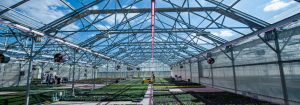LED grow lights are a means of production for a grower, so lifetime discussions are mainly centred around the photon flux depreciation. Since the expected lifetime of LED grow lights is usually very long, the amount of claimed hours cannot possibly be measured before a product is introduced to the market. Therefore, manufacturers use shorter measurements and extrapolate those to define their predictions over time. This requires a deep understanding of which design parameters are critical to extend the LED grow light lifetime, and sufficient statistical knowledge to make the correct calculations. Not all suppliers do this in a similar and, therefore, comparable way. Consequently, the quality of lifetime predictions varies widely.
There are a couple of internationally recognised standards that Signify uses when predicting a product’s lifetime. Here are two of them:
- IES LM-80 describes how to measure photon flux maintenance over time of LEDs
- IES TM-21 describes how to make consistent lifetime projections based on LM-80 test results
When applying the LM-80 standard, a minimum of 6,000 hours of testing of the LED package is required. Of course, LED grow lights are capable of lifetimes well beyond 6,000 hours. That is where standard TM-21 comes in. TM-21 allows you to make a lifetime projection by multiplying the lifetime duration gathered by the LM-80 standard by up to 6 times. Tests for the LM-80 standard typically run for 6,000 to 10,000 hours, so lifetime projections based on TM-21 result in a projection of up to 36,000 to 60,000 hours. After this period, it does not mean the LED grow light will fail, it is just the limit that can be claimed when using the international TM-21 standard. The reason why you cannot claim a longer period using this standard is because it ensures that projections do not exceed the statistical confidence levels, which would make them untrustworthy. This also means that claims above 60,000 hours cannot be substantiated.
Of course, there are other factors that influence the lifetime expectancy of an LED grow light. The design itself is of critical importance, mainly because it is designed to regulate the heat generated by the LEDs. The optics, the driver and the design are parameters that define performance and should be considered when defining lifetime expectancy. As a customer, you should keep in mind that using the same LEDs in a different product does not mean that the performance over time will be the same.
There are three ways to define the lifetime of the grow light module:
- First, assess the robustness of our product design by ‘ageing’ our grow lights and some of the critical components under extreme conditions comparable to the ‘drawer’ tester at IKEA. These accelerated tests show how our products behave during years of operation in a harsh greenhouse environment.
- Second, put different LED grow lights through an endurance test. We turn the lights on for years and measure the photon flux at regular intervals. The temperature and humidity of the greenhouse are copied in this set-up.
- Third, record customer measurement data over the years, collected in several real-life projects. All real-life test data is compared with our projected photon flux depreciation to build confidence in the performance claims we make. This data confirms that we deliver what we promise!





